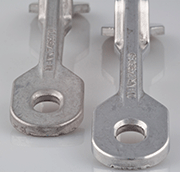E-Archive
Good Vibrations
in Vol. 15 - March Issue - Year 2014
Branch Specific Finishing

Picture 1: Coin blank finishing for longevity of money

Picture 2: Chain finishing for better safety

Picturs 3: Die casting with better surface quality
Industrial branches have their own very specific properties in nearly all fields of economic life. The economic rules within branches differ sometimes very strongly. Every branch has its own set of game rules for economic success or defeat.
The same is true for the finishing of the core products of different branches. Economic success is strongly influenced by the quality of a product. Quality often is seen as a set of features, which parameters are defined by the customer. A more pragmatic view could describe quality as "fitness for purpose" or the non-inferiority or superiority of something. A part with high quality has � simply put- the ability to perform satisfactorily in service, and is suitable for its intended purpose.
The appearance of surfaces today is per se, a quality feature, because people's perception of a product is at the first view considerably influenced by the optical and haptic impression of the surface, nearly independent of the kind of product.
Apart from that perceptional perspective the mechanical needs for more accuracy of single workpieces have risen steadily in step with technological progress. Longevity, safety, and product image-related issues are becoming more and more important for business success.
The surface finishing industry has responded to these demands. In former years, one machine type was recommended for a very broad variety of finishing purposes. It started with a one-box-for-all-solution. The target was a "better surface". One step further, the industry divided different kinds of surfaces, and the finishing process became a polishing, a deburring, a smoothening, an edge-breaking, or whatever-the-focus-was surface. Different machine types for different workpieces and volumes have been constructed. The originally used simple stones were refined into artificially produced finishing media made of different materials and shaped in special geometrical forms. In step with this, the chemical evolution of compounds made its way to a broad spectrum of special additives for different kinds of workpiece materials.
So today, the experience of surface finishing methods and processes is really profound. Even on amazon.com you find literature on mass finishing machines and its processes. Mass finishing has evolved from its niche existence to a central production step with a commonly accepted deep influence on the final product quality.
Leading companies in this sector have now specialized the product and knowledge range on the finishing process optimization for specific branch products. Only a few, especially in Germany, have even managed to become a partner of certain industries in developing suited finishing processes for their products.
One German supplier for example, is offering special solutions for the aerospace industry and the medical sector of human implants. Another competitor is actually focusing on the gastronomic sector and the effective automated cleaning of large quantities of cutlery. But both also have a very broad classical spectrum of finishing customers. A third company is a world-wide accepted specialist in coin blank finishing and is focusing its research and development activities inter alia on industrial chain products and on die-casting workpieces.
This kind of specialisation has led to very successful special process developments for the customer companies. Some of those process receipts for example, for chains, are able to push the product quality enormously. So the competition between the finishing suppliers has changed also. It is not only about machine, price and service quality (on an equally high level in Germany), but especially the platform, of better ideas and creative process concepts as well. Space-saving construction, higher outputs, a high automation degree and integrated parts logistics are expected standards; the challenge is even better processes for maximum part quality.
Some of these process receipts are not a secret. Many branches have a kind of "golden standard", which works in most cases. So the die casting industry is often working with hardened plastic ultra chips, a compound called K-891-U with a great fat-dissolving power, and with floculant media FM 1009 with its intense cleaning power for the process water.
But the mixture of ingredients is only one part of the treatment success truth. Treatment sequences combined with machine technology and extended tests with different configurations are the road to deep process know-how. Specialisation is always also an investment of time and resources into a certain project. In the case of finishing processes it pays for itself, because companies have noticed that there is a great difference between the application of surface finishing and the best possible surface finishing.
Good Vibrations
by Mathieu Geuting
Spaleck Oberflächentechnik GmbH & Co. KG, Germany
Tel. +49.2871.9500 14
Fax +49.2871.9500 95
E-mail: m.geuting@spaleck.biz



























